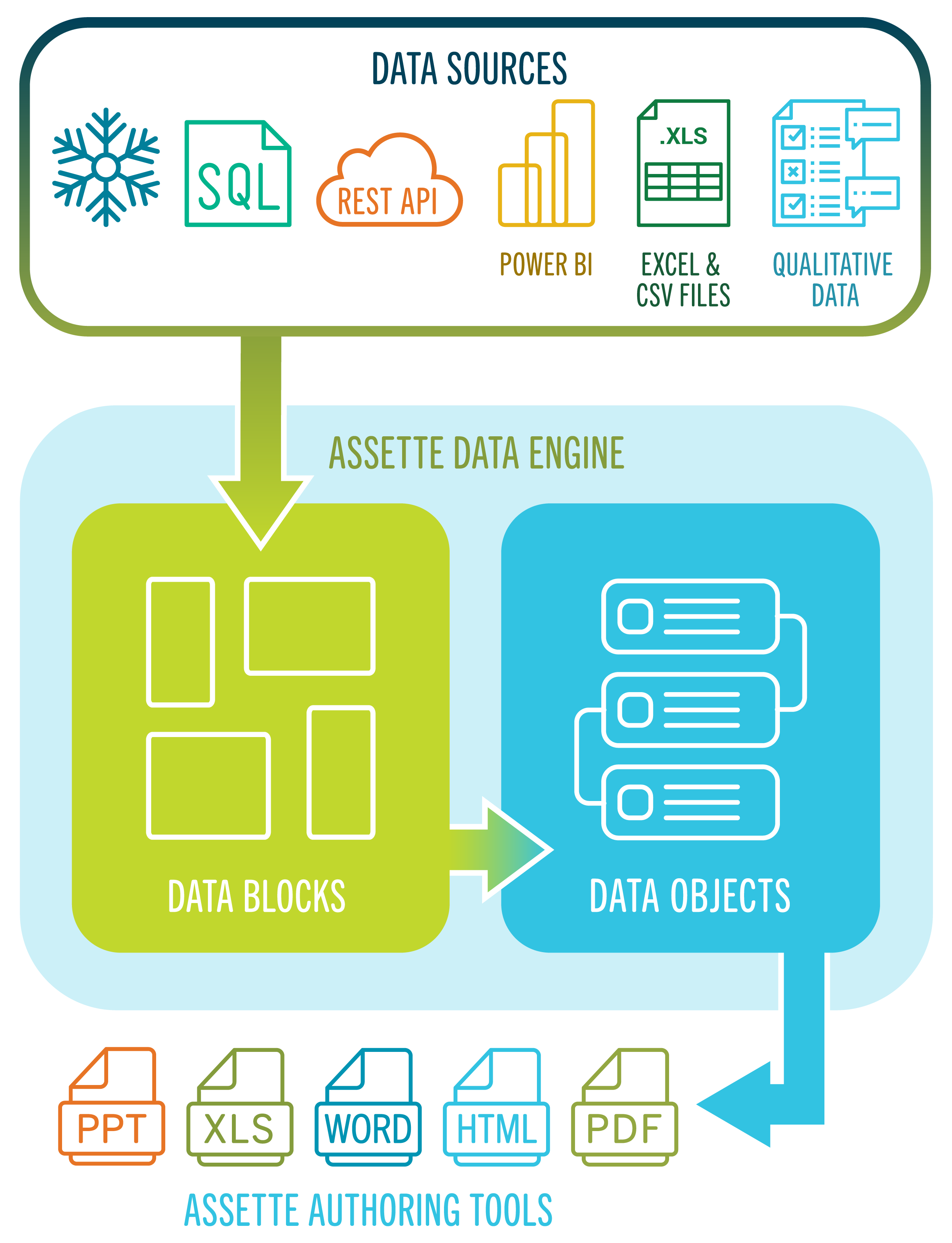Turning investment data into content for your clients and prospects requires accessible and easy-to-work-with data – for everyone on your team.
We’ve eliminated the siloed, IT-required approach to working with data. With Assette, your marketers, client service team, and sellers create engaging content on-the-fly using no-code editors and without help from IT. Now, your IT team stays focused on data gathering and modeling, and your data analysts focus on making this data available to marketing.
How it works
At the core of Assette software is the Data Engine. It sits between your data platform and the tools used to create and review content. The Data Engine interfaces with your data platform and exposes that data in the Authoring Tools area of Assette.
Layers of the Data Engine
There are two layers in the Data Engine. The Data Blocks layer prepares and calculates. The Data Objects layer arranges and exposes.

Common data sources Assette interfaces with: Snowflake, SQL Server, Mongo DB, DAM systems, HR systems, and on-prem databases. Qualitative data can be stored in Assette, reside in your DAM, HR, or other platforms, and be exposed via APIs or SQL, or a mix of all.
The Data Blocks Layer
Interfaces with your data platform and prepares datasets – called data blocks – for easy access and use by data objects. Your data analysts with programming knowledge use Python to develop data blocks, making it easy for you to work with APIs and perform sophisticated calculations and data processing. A single data block can be used by multiple data objects to arrange data in different ways.
The Data Blocks layer is like the data query layer in BI tools (or the stored procedure layer in traditional reporting tools). A data block exposes data like a query output or stored procedure, except it is based on Python, runs on cloud-native Azure serverless technology, and all data preparation is done in memory without storing data in Assette.
The Data Objects Layer
Arranges data into marketer-friendly datasets, called data objects. Your data analysts and even tech-savvy marketers use a low-code editor to define how data should be used to generate content. The Data Objects layer grabs and shows already-prepared data from the Data Blocks Layer. A single data object can be used by multiple content components in different formats.
In the visualization layer of BI tools (and the display layer in traditional reporting tools), one report definition language defines how to arrange and style datasets. Assette has separated these aspects.
- The Data Objects layer arranges your datasets by adding metadata that defines headings, detail rows, total rows, footnotes, and other parts in the dataset. The Data Objects layer also supports data operations such as sorting and grouping.
- Marketer-friendly editors based on PowerPoint, Word, Excel, and HTML then use the data objects to define how data turns into content components such as tables, charts, and text. This includes the styling that reflects your branding.
Benefits of Layers
Using a layered approach in the Assette Data Engine delivers important benefits:
- Build once, use everywhere: Once a data object is created, it can be used in any Assette module and for any format. For example, a single performance data object can be used in pitchbooks, client reports, client presentations, and investment commentary. It can be used to generate PowerPoint, Excel, Word, PDF, HTML, and any other supported format as well as send data to your website or other applications.
- Separate Developer Tasks: The Data Engine enables you to separate developer-required work from tasks non-developers can complete. Data analysts create a set of marketer-understandable data blocks, and then the marketing team leverages these data blocks to create data objects that match content needs.
- Decrease time to implement: With Assette, as you add modules, the additional time to automate new content and train users rapidly decreases. You simply put existing data blocks and data objects to work in new modules and content formats.